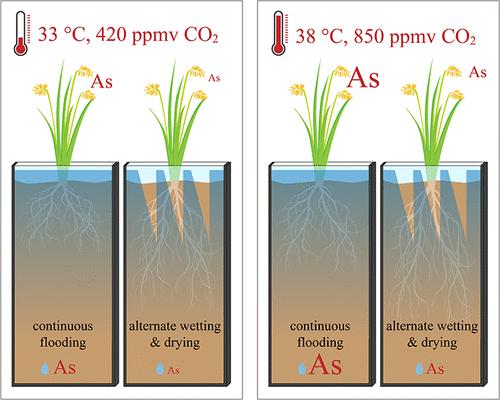Alternate Wetting and Drying Limits Arsenic in Porewater and Rice Grain under Severe Future Climate Conditions
IF 11.3
1区 环境科学与生态学
Q1 ENGINEERING, ENVIRONMENTAL
引用次数: 0
Abstract
Climate change, coupled with widespread soil arsenic (As) contamination, is expected to decrease rice yields and increase grain As, threatening food security. One promising mitigation strategy is alternate wetting and drying (AWD) irrigation. However, AWD has not previously been tested under potential future climate conditions. Using rhizoboxes to visualize the rhizosphere, we evaluated the efficacy of AWD for limiting porewater and grain As under both current (daily high of 33 °C and 420 ppmv CO2) and severe warming conditions (daily high of 38 °C and 850 ppmv CO2). Compared to continuous flooding, AWD decreased cumulative As exposure 10 cm below the surface by 8.2× under a 33 °C climate and by 15.9× under a 38 °C climate. Grain total As concentrations decreased by 1.5× with AWD under a 33 °C climate and by 1.3× under a 38 °C climate. Porewater cadmium (Cd) concentrations often increased following drainage but never exceeded 1 μg L–1, and grain Cd concentrations were 14.7× to 119.7× lower than grain As concentrations. Both AWD and the 38 °C and 850 ppmv CO2 climate conditions enhanced root growth. Our findings indicate that AWD may still be an effective As mitigation strategy under severe future climate conditions.

未来恶劣气候条件下,干湿交替限制孔隙水和稻米中的砷含量
气候变化加上广泛的土壤砷污染,预计将导致水稻产量下降,粮食砷增加,威胁粮食安全。一种有希望的缓解策略是干湿交替灌溉(AWD)。然而,在此之前,AWD还没有在潜在的未来气候条件下进行过测试。利用根箱可视化根际,我们评估了AWD在当前(日最高温度33°C和420 ppmv CO2)和严重变暖条件(日最高温度38°C和850 ppmv CO2)下限制孔隙水和籽粒砷的效果。与连续注水相比,在33°C气候条件下,AWD使地表以下10 cm处的累积砷暴露减少了8.2倍,在38°C气候条件下减少了15.9倍。在33℃气候条件下,随AWD的增加,籽粒总砷浓度下降了1.5倍,在38℃气候条件下下降了1.3倍。孔隙水镉(Cd)浓度随排水而增加,但从未超过1 μg L-1,籽粒Cd浓度比籽粒As浓度低14.7 ~ 119.7倍。AWD和38°C和850 ppmv CO2气候条件均促进了根系生长。我们的研究结果表明,在未来严峻的气候条件下,AWD可能仍然是一种有效的As缓解策略。
本文章由计算机程序翻译,如有差异,请以英文原文为准。
求助全文
约1分钟内获得全文
求助全文
来源期刊

环境科学与技术
环境科学-工程:环境
CiteScore
17.50
自引率
9.60%
发文量
12359
审稿时长
2.8 months
期刊介绍:
Environmental Science & Technology (ES&T) is a co-sponsored academic and technical magazine by the Hubei Provincial Environmental Protection Bureau and the Hubei Provincial Academy of Environmental Sciences.
Environmental Science & Technology (ES&T) holds the status of Chinese core journals, scientific papers source journals of China, Chinese Science Citation Database source journals, and Chinese Academic Journal Comprehensive Evaluation Database source journals. This publication focuses on the academic field of environmental protection, featuring articles related to environmental protection and technical advancements.
 求助内容:
求助内容: 应助结果提醒方式:
应助结果提醒方式:


